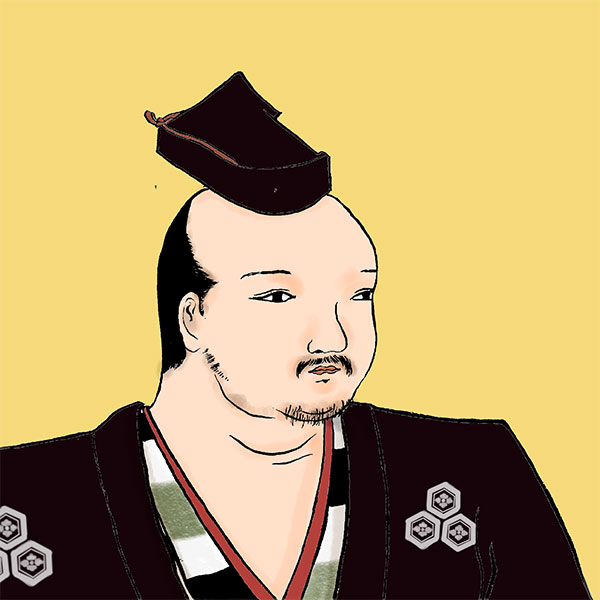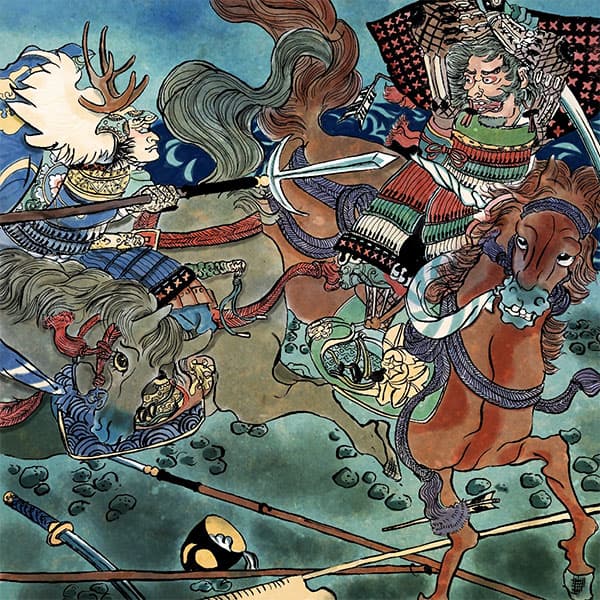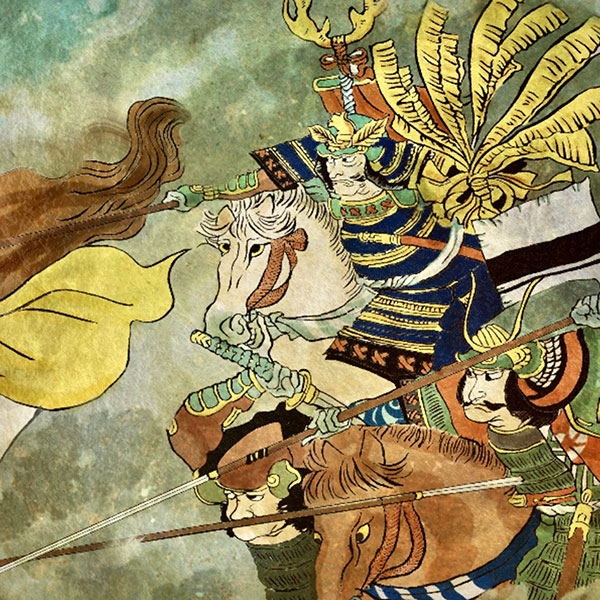Nagamasa Asai (1/2)The last head of the Asai family in Kitaomi

Nagamasa Asai
- Article category
- biography
- name
- Nagamasa Asai (1545-1573)
- place of birth
- Shiga Prefecture
- Related castles

Ichijodani Asakura Residence
- related incident
During the Sengoku period, Omi Province was an important transportation hub. Controlling this area also led to closer unification of the country. The Asai family ruled Kita-Omi, which was on the route from Gifu to Kyoto. The last head of the family, Nagamasa Asai, is the main character this time. What was his life like as he was also the husband of Oda Nobunaga's sister Oichi? Why did you betray Nobunaga? Introducing his turbulent life.
From birth to inheritance of family headship
It is said that he was born in 1545 as the eldest son of Hisamasa Asai in Kannonji Castle in Minami-Omi, the residence of the Rokkaku clan (present-day Azuchi-cho, Omihachiman City, Shiga Prefecture). His childhood name was Saruyashamaru.
The Asai clan was directly responsible for ousting the Kyogoku clan, the shugo of northern Omi, through the gekokujo, but lost in a battle with the Rokkaku clan, the shugo of southern Omi at the time, and Ryo Asai, the first head of the family. He even lost the territory he had acquired during the reign of Masa (Nagamasa's grandfather) and became a vassal to the Rokkaku clan.
For this reason, Nagamasa himself seems to have been treated as a hostage along with his birth mother, Ono-dono. His father, Hisamasa, put effort into diplomacy with the Rokkaku clan and managed to maintain northern Omi. There were many vassals who opposed Hisamasa's policies, and military commanders who had been active in the previous generation were treated poorly in the name of generational change, so there was an aspect of instability.
When Nagamasa celebrated his Genpuku (genpuku) at the age of 15, the Rokkaku clan asked Nagamasa to call himself Kenmasa, taking the character of Yoshikata Rokkaku, the head of the Rokkaku clan, to make it clear that Asai was a vassal. He also forced him to marry the daughter of Sadatake Hirai, a vassal of the Rokkaku clan.
Expansion of the Asai family and decline of the Rokkaku family
In mid-August 1560, at the age of 16, Kenmasa (Shinkuro) led an army and showed off his impressive fighting skills at the Battle of Norada against the Rokkaku army.
The vassals, who were dissatisfied with the situation in which they were subject to the Rokkaku clan, began to place their hopes on Kenmasa (Nagamasa). His father, Hisamasa, was exiled to Chikubu Island and forced to retire, and Nagamasa inherited the headship of the family in a manner that was close to usurpation.
In order to make clear his intention to secede from the Rokkaku clan, Nagamasa returned Sadatake Hirai's daughter to the Rokkaku clan and changed the name ``Kenmasa'' back to Shinkuro.
It is said that the reason for the victory in the Battle of Norada was that unlike the Rokkaku clan, who could only prepare a patchwork of military equipment in a short period of time, Hisamasa began preparing for the battle from around the time he retired.
There is also a theory that when Nagamasa separated from the Rokkaku clan, he entered into a vassal-servant relationship with the Asakura clan. This is due to the appearance of documents in which the Asai clan positions the Asakura clan as ``Oyagata-sama'' (``Documents owned by the Shimogo Mutual Aid Society'' and ``A collection of documents from three generations of the Asai clan''), and ``Asai-dono'' and ``Asai-mae'' in Ichijodani. This theory comes from the fact that the place name remains. Regarding the latter in particular, it is said that the name of the place is derived from the residence given to the Asai clan in Ichijodani, suggesting that they were not in an equal alliance, but were serving the Asakura clan (Yoshikage).
In addition, there were cases in which the kokushu of the time were subordinate to multiple feudal lords who were not in conflict with each other, and even if Nagamasa, who was subordinate to the Asakura clan, married Oda Nobunaga's sister and formed a new vassal relationship, the Asakura clan It seems that this was allowed as long as Mr. Oda did not come into conflict.
In 1563, Goto Kentoyo, the chief vassal of the Rokkaku clan, was murdered by Yoshiharu, the head of the Rokkaku clan (Kannonji Riot). Due to this uproar, many people left the Rokkaku clan and joined the Azai family, and the failure of the Rokkaku clan's reform was decisive, leading to its gradual weakening.
In the same year, during Nagamasa's expedition to Mino, the Rokkaku clan, who had planned to stay away, moved his army, so Nagamasa turned his army around and defeated the Rokkaku army. Akao Kiyotsuna, who was tasked with protecting the shrine, was doing a splendid job with his 500 soldiers.
Although these two events allowed the Asai clan to expand their territory, a stalemate continued afterward due to ceasefire negotiations with the Rokkaku clan.
Alliance with Oda Nobunaga and Oichi's handover
In the 1560s, Oda Nobunaga was looking for a way to break the stalemate with the Saito clan in Mino Province, and sent Mitsuharu Fuwa as a messenger to the Azai family to propose an alliance to Nagamasa.
As a sign of their alliance, the Oda and Asai families arrange a marriage of convenience. Around September 1567, Nagamasa married Nobunaga's younger sister Oichi. There are various theories regarding the timing of Nagamasa and Ichi's marriage. There are several theories such as 1564 (7th year of Eiroku) and 1565 (8th year of Eiroku), and some parts are still unclear.
Through the alliance between the Oda family and the Azai family, Nobunaga was able to secure Omiguchi, which served as a route to Kyoto, and at the same time gained a foothold from which to conquer Mino Province. Nobunaga was delighted with the formation of the alliance, and it is said that although it was customary at the time for the Azai family to provide the funds for the marriage, Nobunaga himself paid for the entire marriage.
It is said that when Nagamasa and Oichi got married, he received Nobunaga's character and changed his name to Nagamasa, but he also stopped using the kao of the Kensei era and made a kao with the character ``cho'' tilted to the right. There is also a story that it was.
As a result of this alliance, in July 1568, Yoshiaki Ashikaga, who was staying in Echizen Province, gave up on Yoshikage Asakura, who had shown no intention of going to Kyoto, and went to work with Nobunaga in Owari. You will have to take shelter.
In September, Nobunaga began his march to Kyoto. On his way to Kyoto, he attacks the rebellious Rokkaku clan. As a result, the power of the Rokkaku clan, Nagamasa's enemy, was reduced to Koka District in Minami Omi. The Asai clan also provided cover for Kyoto while protecting Yoshiaki.
Breaks alliance with Nobunaga and forms Nobunaga encirclement network
In the first year of Genki (1570), Nobunaga and Tokugawa Ieyasu passed through the west coast of Lake Biwa and set out to capture the Asakura castles of Wakasa and Echizen. For this reason, Nagamasa suddenly betrayed his ally Nobunaga and attacked the Oda and Tokugawa forces from behind.
- related incident

- WriterTomoyo Hazuki(Writer)I have loved history and geography since my student days, and have enjoyed visiting historical sites, temples and shrines, and researching ancient documents. He is especially strong in medieval Japanese history and European history in world history, and has read a wide range of things, including primary sources and historical entertainment novels. There are so many favorite military commanders and castles that I can't name them, but I especially like Hisashi Matsunaga and Mitsuhide Akechi, and when it comes to castles, I like Hikone Castle and Fushimi Castle. Once you start talking about the lives of warlords and the history of castles, there's a side of you that can't stop talking about them.





